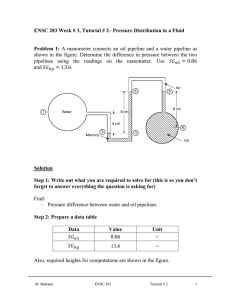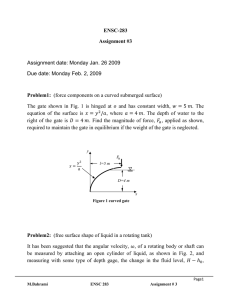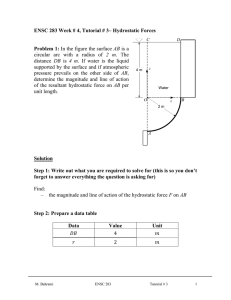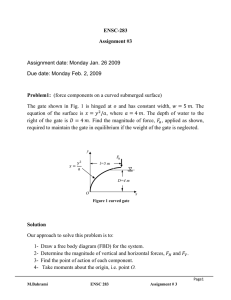Hydrostatic
advertisement
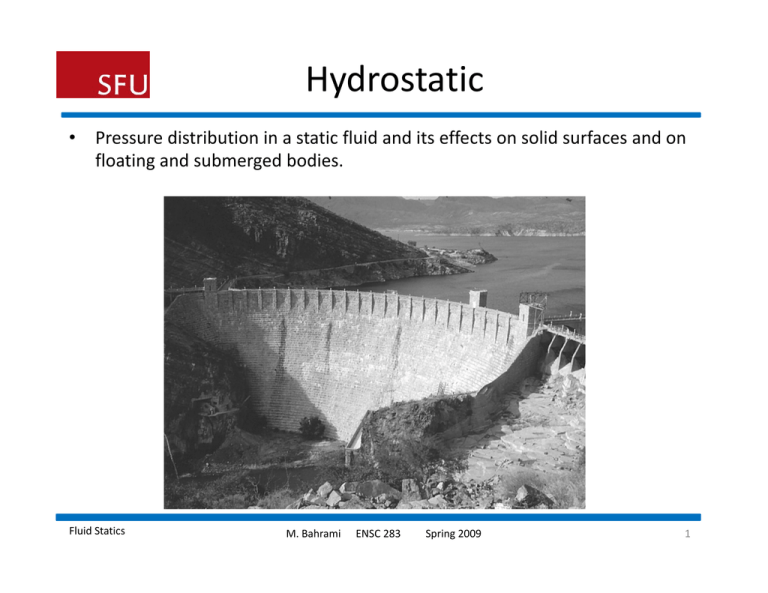
Hydrostatic • Pressure distribution in a static fluid and its effects on solid surfaces and on floating and submerged bodies. Fluid Statics M. Bahrami ENSC 283 Spring 2009 1 Fluid at rest • hydrostatic condition: when a fluid velocity is zero, the pressure variation is due only to the weight of the fluid. • • There is no pressure change in the horizontal direction. There is a pressure change in the vertical direction proportional to the density, gravity, and depth change. • In the limit when the wedge shrinks to a point, Fluid Statics M. Bahrami ENSC 283 Spring 2009 2 Pressure forces (pressure gradient) • Assume the pressure vary arbitrarily in a fluid, p=p(x,y,z,t). • • The pressure gradient is a surface force that acts on the sides of the element. Note that the pressure gradient (not pressure) causes a net force that must be Note that the pressure gradient (not pressure) causes a net force that must be balanced by gravity or acceleration. Fluid Statics M. Bahrami ENSC 283 Spring 2009 3 Equilibrium • The pressure gradient must be balanced by gravity force, or weight of the element, for a fluid at rest. • The gravity force is a body force, acting on the entire mass of the element. Magnetic force is another example of body force. Fluid Statics M. Bahrami ENSC 283 Spring 2009 4 Gage pressure and vacuum • The actual pressure at a given position is called the absolute pressure, and it is measured relative to absolute vacuum. P Pgage Pabs Pvac Patm Fluid Statics M. Bahrami ENSC 283 Absolute Ab l t (vacuum) = 0 Spring 2009 5 Hydrostatic pressure distribution • For a fluid at rest, pressure gradient must be balanced by the gravity force • • Recall: p is perpendicular everywhere to surface of constant pressure p. In our customary coordinate z is “upward” and the gravity vector is: where g = 9.807 m/s where g = 9 807 m/s2. The pressure gradient vector becomes: The pressure gradient vector becomes: Fluid Statics M. Bahrami ENSC 283 Spring 2009 6 Hydrostatic pressure distribution • Pressure in a continuously distributed uniform static fluid varies only with vertical distance and is independent of the shape of the container. The pressure is the same at all points on a given horizontal plane in a fluid. • For liquids, which are incompressible, we have: • The quantity, p⁄γ is a length called the pressure head of the fluid. • Fluid Statics M. Bahrami ENSC 283 Spring 2009 7 The mercury barometer Patm = 761 mmHg • Mercury has an extremely small vapor Mercury has an extremely small vapor pressure at room temperature pressure at room temperature (almost vacuum), thus p1 = 0. One can write: Fluid Statics M. Bahrami ENSC 283 Spring 2009 8 Hydrostatic pressure in gases • Gases are compressible, using the ideal gas equation of state, p=ρRT: • For small variations in elevation, “isothermal atmosphere” can be assumed: In general (for higher altitudes) the atmospheric temperature drops off linearly with z T≈T0 ‐ Bz where T0 is the sea‐level temperature (in Kelvin) and B=0.00650 K/m. • • Note that the Patm is nearly zero (vacuum condition) at z Note that the P is nearly zero (vacuum condition) at z = 30 km. = 30 km Fluid Statics M. Bahrami ENSC 283 Spring 2009 9 Manometry • A static column of one or multiple fluids can be used to measure pressure difference between 2 points. Such a device is called manometer. • Adding/ subtracting γ∆z / as moving down/up in a fluid column. / • Jumping across U‐tubes: any two points at the same elevation in a continuous mass of the same static fluid will be at the same pressure. Fluid Statics M. Bahrami ENSC 283 Spring 2009 10 Hydrostatic forces on surfaces Consider a plane panel of arbitrary shape completely submerged in a liquid. • • The total hydrostatic force on one side of the plane is given by: Fluid Statics M. Bahrami ENSC 283 Spring 2009 11 Hydrostatic forces on surfaces • After integration and simplifications, we find: • The force on one side of any plane submerged surface in a uniform fluid equals the pressure at the plate centroid times the plate area, independent of the shape of the plate or angle θ. p p p g • The resultant force acts not through the centroid but below it toward the high pressure side. Its line of action passes through the centre of pressure g p p g p CP of the plate (xCP, yCP). Fluid Statics M. Bahrami ENSC 283 Spring 2009 12 Hydrostatic forces on surfaces • Centroidal moments of inertia for various cross‐sections. • Note: for symmetrical plates, Ixyy = 0 and thus xCP = 0. As a result, the center of pressure lies directly below the centroid on the y axis. Fluid Statics M. Bahrami ENSC 283 Spring 2009 13 Hydrostatic forces: curved surfaces • The easiest way to calculate the pressure forces on a curved surface is to compute the horizontal and vertical forces separately. • The horizontal force equals the force on the plane area formed by the projection of the curved surface onto a vertical plane normal to the component. t • The vertical component equals to the weight of the entire column of fluid, both liquid and atmospheric above the curved surface. FV = W2 + W1 + Wair Fluid Statics M. Bahrami ENSC 283 Spring 2009 14
